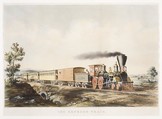The Express Train
Charles Parsons American
Lithographed and published by Currier & Ives American
Not on view
Nathaniel Currier, whose successful New York-based lithography firm began in 1835, produced thousands of hand-colored prints in various sizes that together create a vivid panorama of mid-to-late nineteenth century American life and its history. People eagerly acquired such lithographs featuring picturesque scenery, rural and city views, ships, portraits, hunting and fishing scenes, domestic life and numerous other subjects, as an inexpensive way to decorate their homes or business establishments. As the firm expanded, Nathaniel recruited his younger brother Charles into the business. In 1857, James Merritt Ives (the firm's accountant since 1852 and Charles's brother-in-law) was made a business partner; subsequently renamed Currier & Ives, the firm continued until 1907.
Starting in 1853, Nathaniel Currier (and later Currier & Ives) published thirty prints featuring trains for those Americans wanting pictures of the then-modern mode of transportation that provided a convenient way to travel and ship goods around the country. In this railroad scene by Charles Parsons, a locomotive (with a puff of black smoke trailing from its black smokestack) pulls a tender trimmed with red-and-gold ornamentation, a light brown cargo car and four yellow passenger cars as it heads from left to right across the image. The engineer, stoker and conductor (who stands between passenger and baggage cars) are clearly visible. In the far right distance, there is a town with a church steeple. For nineteenth-century viewers, this print showed how trains were transforming rural America.
Due to rights restrictions, this image cannot be enlarged, viewed at full screen, or downloaded.


